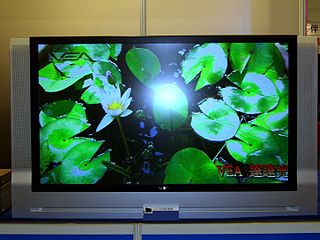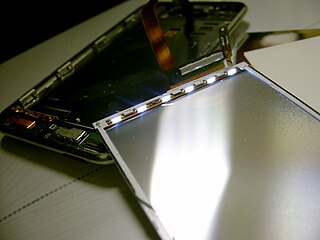
A computer monitor is an output device that displays information in pictorial or text form. A monitor usually comprises a visual display, some circuitry, a casing, and a power supply. The display device in modern monitors is typically a thin-film-transistor liquid-crystal display (TFT-LCD) with LED backlighting having replaced cold-cathode fluorescent lamp (CCFL) backlighting. Previous monitors used a cathode-ray tube (CRT) and some plasma displays. Monitors are connected to the computer via VGA, Digital Visual Interface (DVI), HDMI, DisplayPort, USB-C, low-voltage differential signaling (LVDS) or other proprietary connectors and signals.

A liquid-crystal display (LCD) is a flat-panel display or other electronically modulated optical device that uses the light-modulating properties of liquid crystals combined with polarizers. Liquid crystals do not emit light directly, instead using a backlight or reflector to produce images in color or monochrome. LCDs are available to display arbitrary images or fixed images with low information content, which can be displayed or hidden. For instance: preset words, digits, and seven-segment displays, as in a digital clock, are all good examples of devices with these displays. They use the same basic technology, except that arbitrary images are made from a matrix of small pixels, while other displays have larger elements. LCDs can either be normally on (positive) or off (negative), depending on the polarizer arrangement. For example, a character positive LCD with a backlight will have black lettering on a background that is the color of the backlight, and a character negative LCD will have a black background with the letters being of the same color as the backlight. Optical filters are added to white on blue LCDs to give them their characteristic appearance.

A plasma display panel (PDP) is a type of flat panel display that uses small cells containing plasma: ionized gas that responds to electric fields. Plasma televisions were the first large flat panel displays to be released to the public.

An LCD projector is a type of video projector for displaying video, images or computer data on a screen or other flat surface. It is a modern equivalent of the slide projector or overhead projector. To display images, LCD projectors typically send light from a metal-halide lamp through a prism or series of dichroic filters that separates light to three polysilicon panels – one each for the red, green and blue components of the video signal. As polarized light passes through the panels, individual pixels can be opened to allow light to pass or closed to block the light. The combination of open and closed pixels can produce a wide range of colors and shades in the projected image.

Dolby Laboratories, Inc. is an American company specializing in audio noise reduction, audio encoding/compression, spatial audio, and HDR imaging. Dolby licenses its technologies to consumer electronics manufacturers.
The contrast ratio (CR) is a property of a display system, defined as the ratio of the luminance of the brightest shade (white) to that of the darkest shade (black) that the system is capable of producing. A high contrast ratio is a desired aspect of any display. It has similarities with dynamic range.

A surface-conduction electron-emitter display (SED) is a display technology for flat panel displays developed by a number of companies. SEDs use nanoscopic-scale electron emitters to energize colored phosphors and produce an image. In a general sense, a SED consists of a matrix of tiny cathode ray tubes, each "tube" forming a single sub-pixel on the screen, grouped in threes to form red-green-blue (RGB) pixels. SEDs combine the advantages of CRTs, namely their high contrast ratios, wide viewing angles, and very fast response times, with the packaging advantages of LCD and other flat panel displays. They also use much less power than an LCD television of the same size.

High-dynamic-range rendering, also known as high-dynamic-range lighting, is the rendering of computer graphics scenes by using lighting calculations done in high dynamic range (HDR). This allows preservation of details that may be lost due to limiting contrast ratios. Video games and computer-generated movies and special effects benefit from this as it creates more realistic scenes than with more simplistic lighting models.

Tone mapping is a technique used in image processing and computer graphics to map one set of colors to another to approximate the appearance of high-dynamic-range images in a medium that has a more limited dynamic range. Print-outs, CRT or LCD monitors, and projectors all have a limited dynamic range that is inadequate to reproduce the full range of light intensities present in natural scenes. Tone mapping addresses the problem of strong contrast reduction from the scene radiance to the displayable range while preserving the image details and color appearance important to appreciate the original scene content.
High dynamic range (HDR) is a dynamic range higher than usual, synonyms are wide dynamic range, extended dynamic range, expanded dynamic range.

Large-screen television technology developed rapidly in the late 1990s and 2000s. Prior to the development of thin-screen technologies, rear-projection television was standard for larger displays, and jumbotron, a non-projection video display technology, was used at stadiums and concerts. Various thin-screen technologies are being developed, but only liquid crystal display (LCD), plasma display (PDP) and Digital Light Processing (DLP) have been publicly released. Recent technologies like organic light-emitting diode (OLED) as well as not-yet-released technologies like surface-conduction electron-emitter display (SED) or field emission display (FED) are in development to replace earlier flat-screen technologies in picture quality.
Contrast in visual perception is the difference in appearance of two or more parts of a field seen simultaneously or successively.

A LED-backlit LCD is a liquid-crystal display that uses LEDs for backlighting instead of traditional cold cathode fluorescent (CCFL) backlighting. LED-backlit displays use the same TFT LCD technologies as CCFL-backlit LCDs, but offer a variety of advantages over them.
Helge Seetzen is a German technologist and businessman known for imaging & multimedia research and commercialization.
Dolby Vision is a set of technologies developed by Dolby Laboratories for high dynamic range (HDR) video. It covers content creation, distribution, and playback. It includes dynamic metadata that are used to adjust and optimize each frame of the HDR video to the consumer display's capabilities in a way specified by the content creator.

Dolby Cinema is a premium cinema created by Dolby Laboratories that combines Dolby proprietary technologies such as Dolby Vision and Dolby Atmos, as well as other signature entrance and intrinsic design features. The technology competes with IMAX and other premium large formats such as Cinemark's XD and Regal's RPX.

HDR10 Media Profile, more commonly known as HDR10, is an open high-dynamic-range video (HDR) standard announced on 27 August 2015 by the Consumer Technology Association. It is the most widespread of the HDR formats.
Standard-dynamic-range (SDR) video is a video technology which represents light intensity based on the brightness, contrast and color characteristics and limitations of a cathode ray tube (CRT) display. SDR video is able to represent a video or picture's colors with a maximum luminance around 100 cd/m2, a black level around 0.1 cd/m2 and Rec.709 / sRGB color gamut. It uses the gamma curve as its electro-optical transfer function.
High-dynamic-range television is a technology that improves the quality of display signals. It is contrasted with the retroactively-named standard dynamic range (SDR). HDR changes the way the luminance and colors of videos and images are represented in the signal, and allows brighter and more detailed highlight representation, darker and more-detailed shadows, and a wider array of more intense colors.
The Sony Xperia XZ2 Premium is an Android smartphone manufactured and marketed by Sony. Part of the Xperia X series, the device was announced to the public on April 16, 2018 featuring a 4K HDR display and a MotionEye™ Dual Camera.












